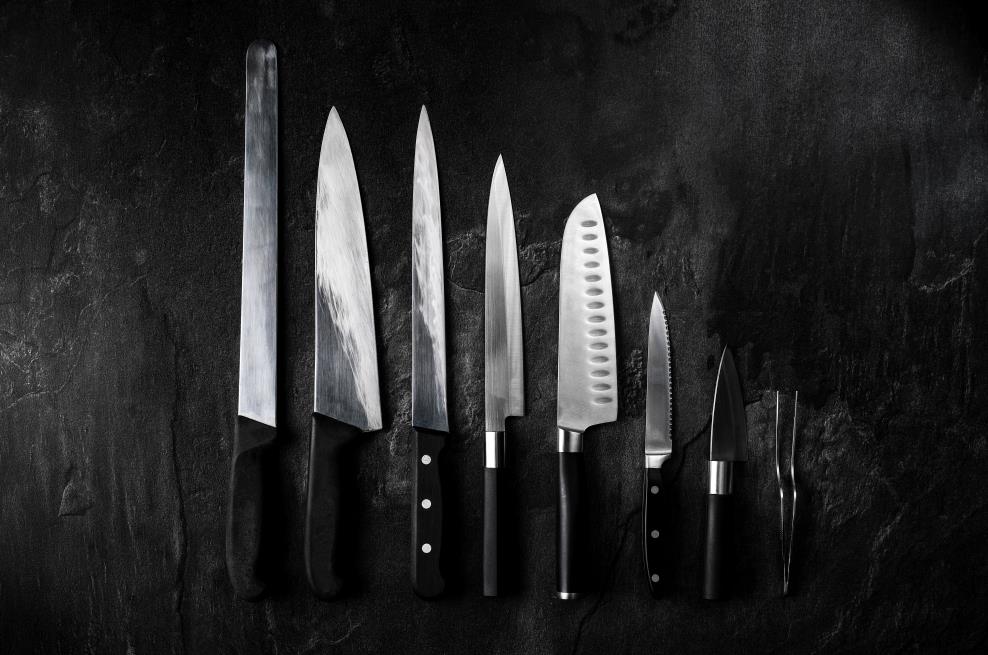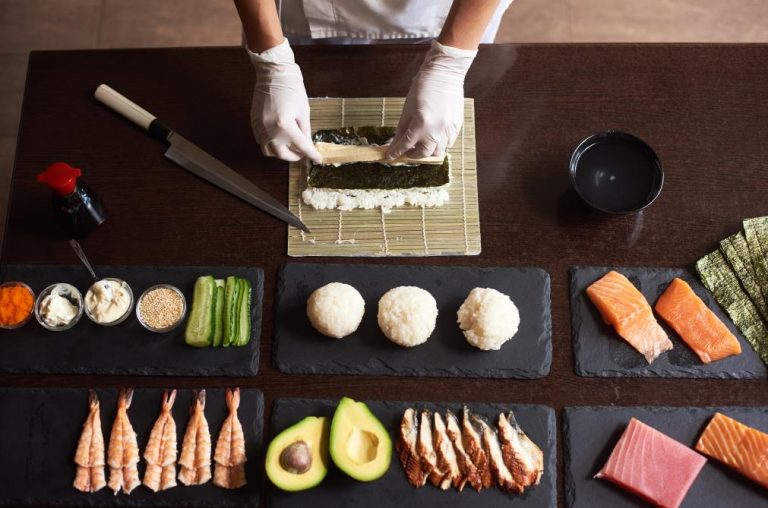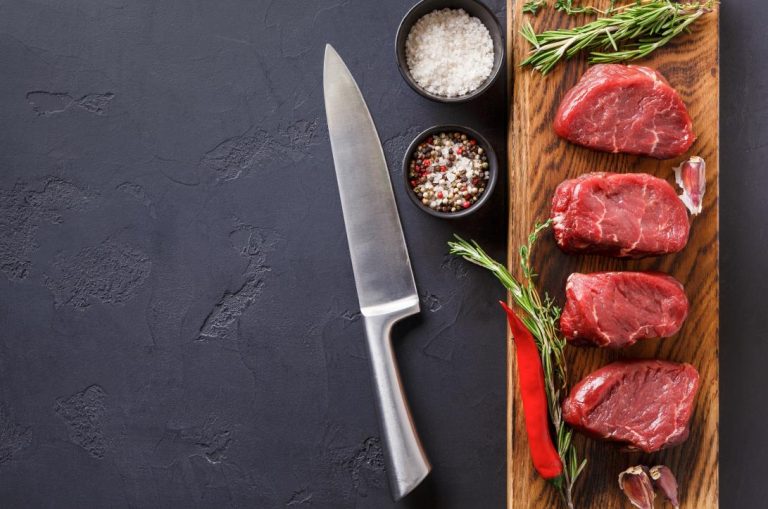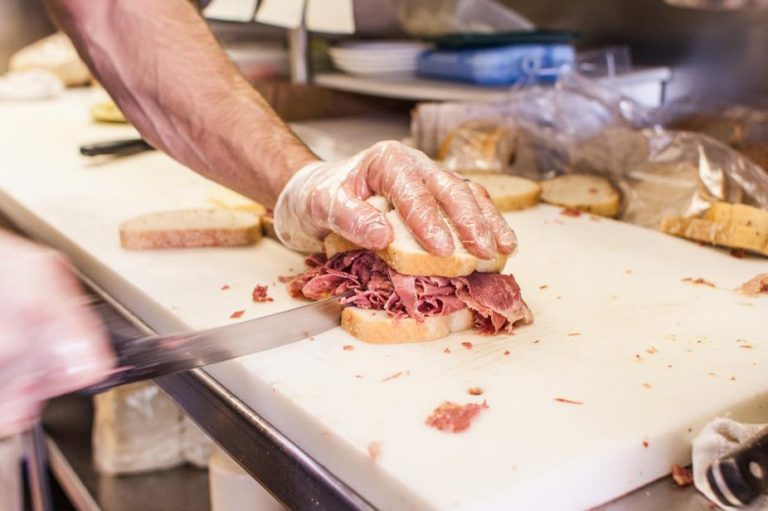Most artists can tell you that a critical aspect of their craft is choosing the right art supplies. Cooking is no different. Chefs know that using the right tool at the right time can make or break a masterful dish.
When it comes to the culinary arts, it’s no surprise that Japanese tools are widely regarded as the golden standard. With over 200 Japanese knife types to choose from, it’s sometimes difficult to bring the perfect blade to an undecided customer.
That’s why we’ve put together this list. For anyone in the knife business, distinguishing between these popular Japanese-style tools is a priceless skill.
The best part about our Japanese Knife Academy? There’s no tuition. Sounds good? Then let’s get you started.
Japanese knives: Introductory course
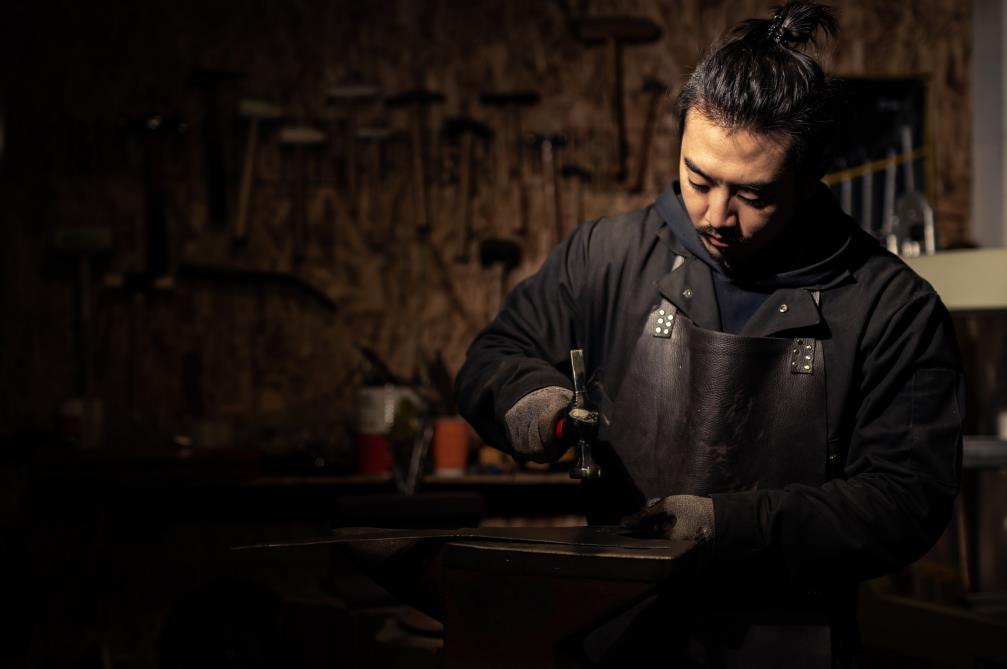
A samurai and a chef walk into a bar. This might be the beginning of a joke, but it’s actually the birth of the flourishing Japanese knife industry we know today.
The oldest Japanese knife dates from the Nara period (710-794) and looks like a miniature version of a samurai sword. For the following 200 years, knives were used mainly by aristocratic classes and were regarded as sacred.
The belief that the chef’s soul would inhabit the knife took root around this period and made way for modern Japanese chefs to pay considerable respect to their tools.
Even today, old knives that break or become too dull to be sharpened aren’t thrown away but buried at special mounds called Hocho-zuka.
During the 16th century, tobacco farmers demanded blacksmiths to produce knives that were sharp enough to harvest the tobacco leaves, building the foundations for the exceptional quality we see today in Japanese knives.
Buy Wholesale Knives and Start Scaling up with Us Today
Contact us and connect with a sales rep to get a free quote.
During the Edo period, rulers established food purity laws in Japan, which encouraged the creation of different types of blades. As a result, their shapes were influenced by the ingredients used in each local cuisine, with most households already having a Deba and a Nakiri in their kitchens.
Japan opened its borders to the West in the Meiji period, and new cooking ingredients like beef were introduced, along with Western cooking and blacksmithing techniques.
These inspired the creation of multi-purpose Japanese blades, such as the Gyuto-bocho, the Eastern version of the well-known chef’s knife.
Fast-forward to modern times, Japan now has more than 200 different types of knives, some of which preserved their traditional features. Many of them, though, were Westernized and adapted to suit the global market.
Multi-purpose Japanese Knives 101
Gyuto
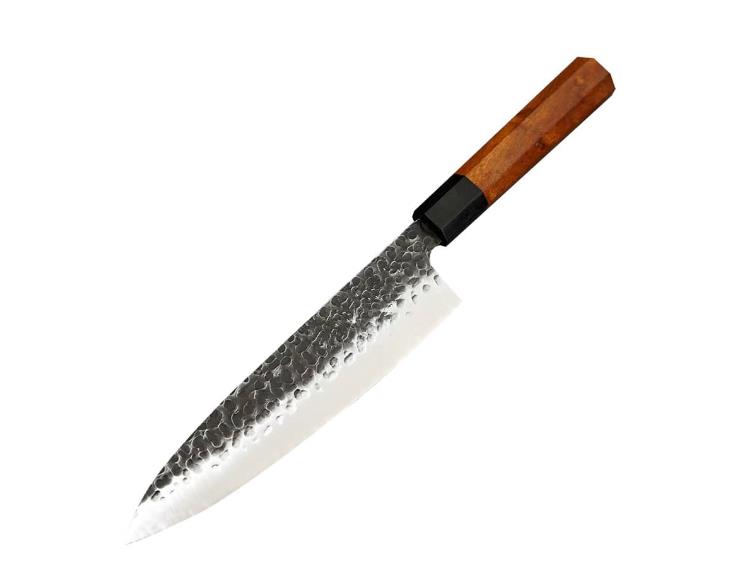
The Gyuto might very well be the jewel of the Japanese craftsmanship’s crown. As one of the most popular types of Japanese knives across the world, this blade comes in several variations across the traditional-Westernized spectrum.
Widely regarded as the Japanese version of a chef’s knife, the Gyuto can be used for rock chopping, pull-cutting, and push-cutting all kind of meats, vegetables, and fruit.
Its design is similar to a Western multi-purpose knife, featuring a slightly curved cutting belly with a flat heel that curves downwards into a sharp, nimble point.
Learn more about the Gyuto:
Gyuto vs. chef’s knife
Apart from minor differences in design, the Gyuto differs from the well-known chef’s knife in a few key aspects. One of the most critical differences lies in the materials used, as the Gyuto preserves the expert craftsmanship of traditional Japanese blades.
Regarding the suitable cutting techniques for each knife, the Gyuto seems to perform better for pull and push cuts, which help with more muscular types of meat.
On the other hand, a Western knife excels at rock chopping, which lends itself well when preparing many different vegetables. Reading a more in-depth comparison of the two will result in extra credits.
Read more about the comparison:
Santoku
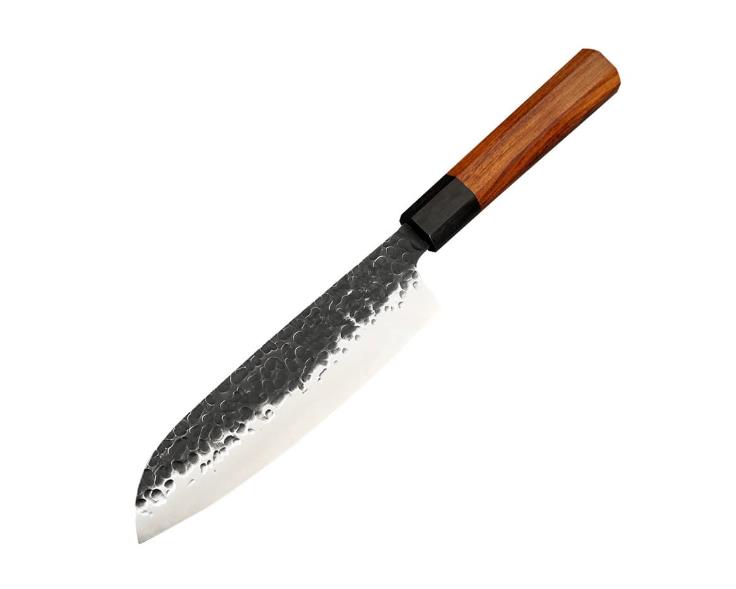
The Santoku-bocho is a versatile tool that has become widely popular recently. Its name translates to “three virtues,” referring to slicing, dicing, and chopping.
With a lightweight blade, typically between 5 and 8 inches, the Santoku can be used for a multitude of tasks around the kitchen. Still, it shines especially bright when employed in the finer culinary arts.
The wide, rectangular blade features a slightly curved belly with little indents on each side, allowing the user to cut fine slices of vegetables, meat, and fish.
It offers excellent forward balance with a rounded top that ends in a sharp point, a shape commonly known as “sheep’s foot.”
Santoku vs. Gyuto
It’s easy to mistake one of these knives for the other since their uses are similar. Both can be used effortlessly to prepare many different foods, and they’re equally comfortable to hold for long periods.
An important distinction people make relates to their size. A Santoku is generally smaller, so it fits nicely in limited spaces or for smaller hands, which is why many female chefs prefer them. Also, since they feature a more delicate blade than Gyutos, these can be used for more refined dishes, where the visual aspect is paramount.
On the other hand, Gyutos perform better with tougher foods and offer a bit more versatility, especially when it comes to meat.
Read more about Santoku vs. Gyuto:
Santoku vs. chef’s knife
Without mentioning the more appealing design of the Santoku, there are still some important distinctions between this blade and a traditional chef’s knife.
The Santoku blade is lighter and sharper, allowing for more precise work. However, Western chefs might dislike this feature, making the knife less effective at cutting through basically any type of food.
Therefore, the Western chef’s knife is considered more effective when a chef needs to switch between various kitchen tasks quickly.
Learn more about the debate:
Kiritsuke
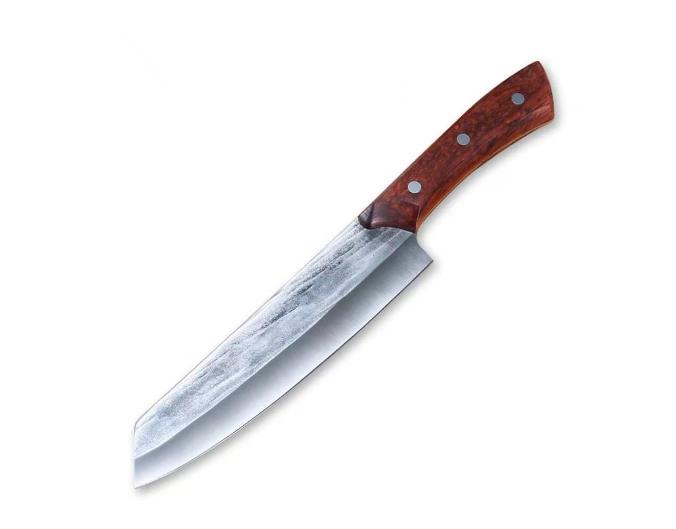
When thinking of the impressive design of a Japanese knife, a Kiritsuke might be the first thing to come to your mind. Even if you don’t yet know the name of it.
This blade is a cross between a Gyuto and a Yanagiba, and it is widely used by executive chefs across Japan. Using it requires a particular skill set, which is why the Kiritsuke is seen as a status symbol.
Typically featuring a single-beveled edge with a completely flat profile, this long knife can be used for fruit and vegetables, fish and poultry, and herbs.
What makes this knife unique is the shape of its tip, called a “reverse-tanto.” The heel angles down towards the cutting edge, where it meets a very sharp point. These two features make it a fantastic choice for preparing delicate, intricate dishes, such as sushi or sashimi.
Learn more about the Kiritsuke:
Bunka
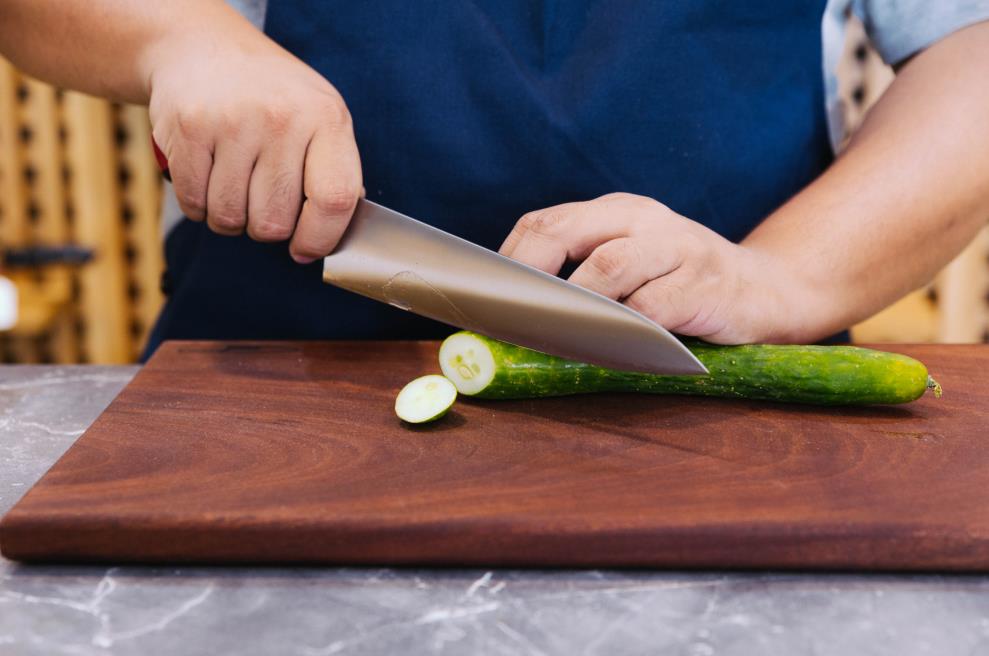
Another multi-purpose tool that deserves a detailed analysis is the Bunka bocho. Roughly translated to “cultural knife,” this tool is a Santoku with a bit of attitude. Their designs are quite similar, with the main difference being the reverse tanto point of the Bunka blade.
It can be used for meat, vegetables, and fruit, but fish and seafood are the stages where the Bunka blade can shine its brightest.
The wide, rectangular blade makes it useful for various tasks around the kitchen, while the precise point allows for more delicate work.
Read more about the Bunka bocho:
Chukabocho
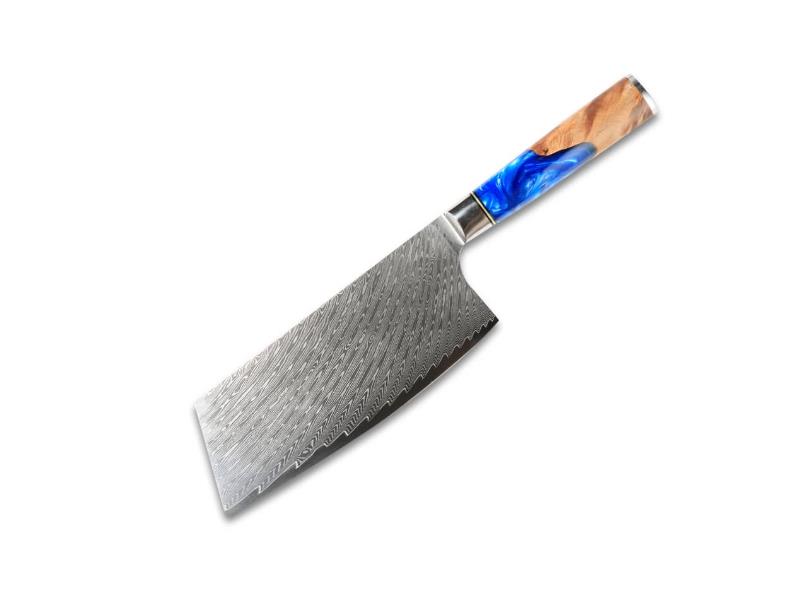
Knowing your knives makes it impossible not to have seen the Chukabocho before. Its name translates to “Chinese cleaver,” which already explains its purpose.
This knife features a wide, completely rectangular blade, with a flat profile, with some variants using a slightly curved cutting belly.
Judging by its design, you’d expect to see this knife in a butcher’s shop, but the Chukabocho is surprisingly versatile. Chefs use it equally well for chopping and dicing meat, fish, and vegetables of all sizes.
With a wide array of uses and a badass design, this blade can make a great addition to any chef’s collection, so make sure to read everything about it.
Learn more about the Chukabocho:
Japanese all-purpose knife discussion
Not all multi-purpose knives are created equal. While their primary purpose is to help the chef deal with most of the tasks coming their way on a typical day, some knives perform better than others for particular tasks.
While Gyuto and Santoku are fantastic choices for any home cook, meat lovers might prefer the Chukabocho for daily cooking.
Likewise, for authentic Japanese cuisine, a Kiritsuke might be better than a Bunka. But that depends solely on the chef’s experience level and frequently prepared dishes.
Ranking these tools is difficult, but you’ll be better prepared for it by reading the following comparison.
Read this complete guide on Japanese all-purpose knives:
The All-Purpose Brawl: Kiritsuke vs. Gyuto vs. Chef’s Knife vs. Santoku
Japanese fish knives 102
Deba
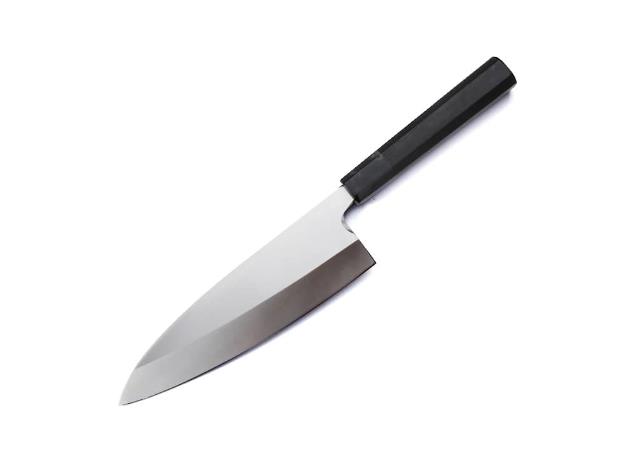
Another traditional, single beveled edge knife is the Deba, extensively used in Japan for breaking down, slicing, deboning, and filleting fish without damaging the delicate meat.
The extremely sharp blade easily cuts through fish bones but performs well with other soft joints like those of poultry.
Its design is one of the most recognizable Japanese knife types, with a thicker spine and a delicate cutting edge, meeting in a sharp, low point.
The curved profile makes it an excellent choice for preparing vegetables, as well, yet the Deba isn’t considered a multi-purpose tool due to its weight, which makes it unsuitable for prolonged use.
Learn more about the Deba:
Yanagiba
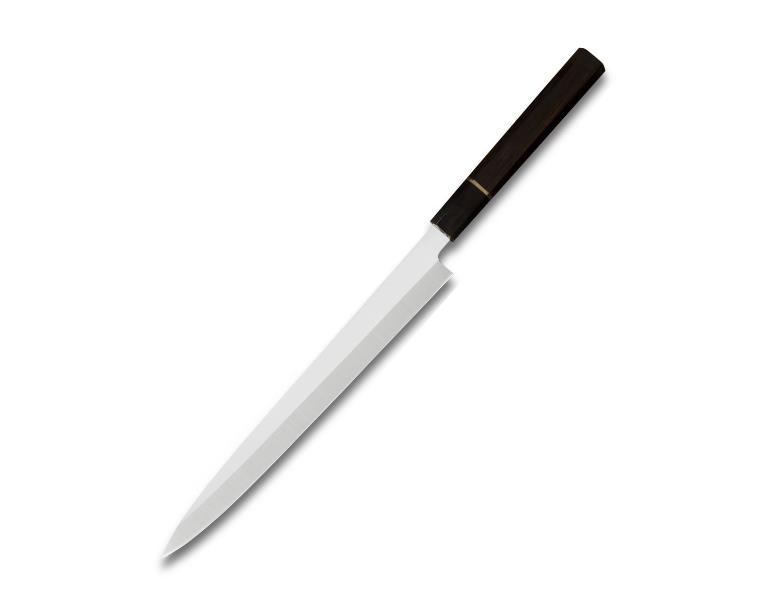
Following the trend of the single-beveled edge, the Yanagiba is possibly the most visually pleasing type of Japanese knife. With a very long, narrow blade ending in a delicate point, this knife is the one tool you can’t miss as a sushi chef.
“Yanagi” translates to “willow leaf,” a shape inherited by this blade, which is quite a bit thicker than a standard chef’s knife.
These qualities allow chefs to cut extremely thin slices of fish and delicate veggies such as cucumber to create intricate dishes.
The hype around this knife is real, so we recommend a further lecture on this knife type for fish enthusiasts or just about anyone who can appreciate beauty.
Learn more about the Yanagiba:
Unagisaki
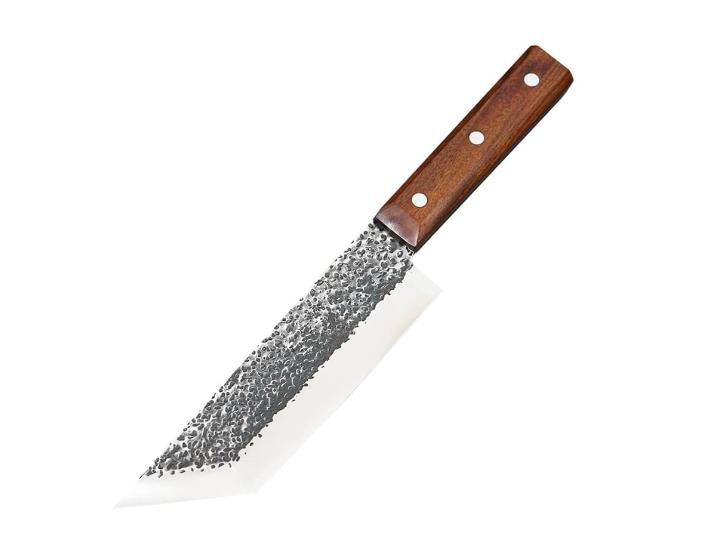
While the Yanagiba was probably named by a poet, the Unagisaki hocho was certainly not. Its name translates to “eel filleting knife,” which is exactly what this knife is used for.
Its blade is quite broad, with a regular tanto point that angles upwards from the short, flat cutting edge.
The very sharp tip is pushed into the eel near the head, then slid down to open up the entire body of the eel. This is where the wide blade comes in handy.
The Unagisaki is thick and features a single bevel, making it impractical for most other purposes. However, specialized chefs can see its value, so it’s helpful to read up on this blade if you’re marketing to professionals.
Learn more about the eel knife:
Japanese specialty knives 103
Nakiri
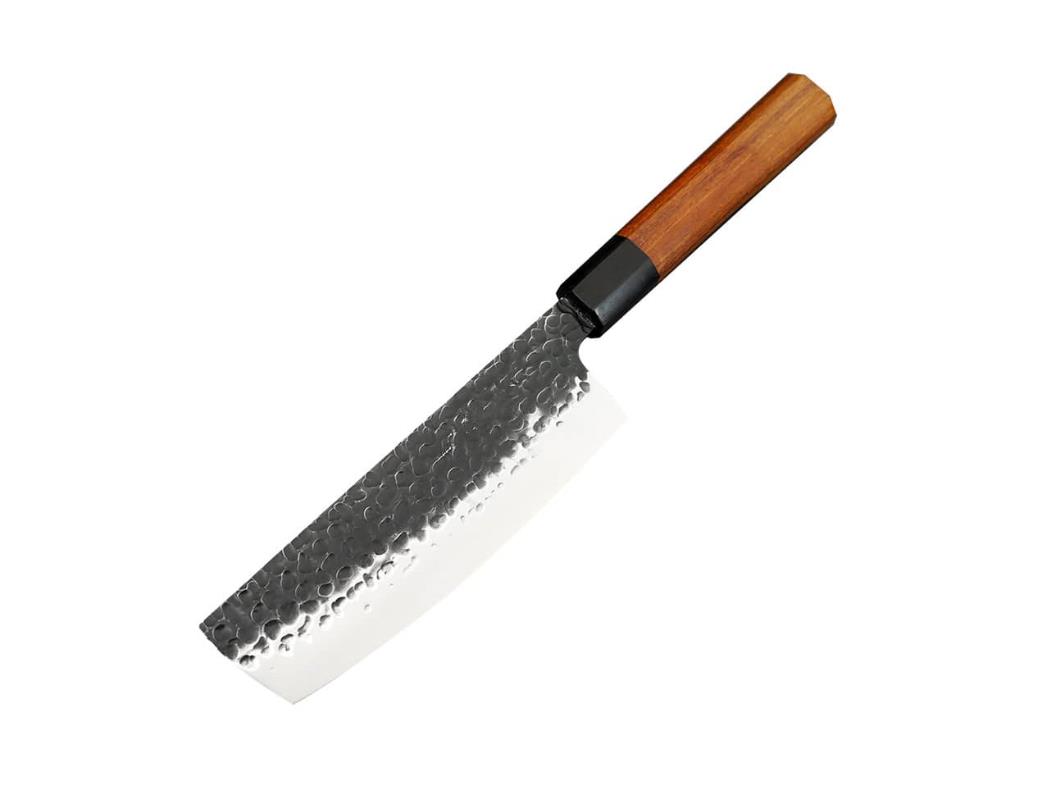
The Nakiri bocho has a long history, being one of the first traditional knives to spread across most Japanese households. Its name translates to “knife for cutting greens,” yet it excels in preparing vegetables of all colors. Along with the Usuba bocho, the Nakiri is a staple in traditional Japanese cuisine since this mainly used vegetables before the West popularized more types of meat.
A Nakiri can be easily recognized from hundreds of knives due to its unique design. It has a wide, rectangular blade and a blunt tip. The flat profile lends itself well when preparing many different veggies and fruit, so the Nakiri is the perfect tool for vegetarian or vegan dishes.
Learn more about the Nakiri:
Nakiri vs. Usuba
The Usuba knife is the direct rival of the Nakiri for preparing vegetables. They are very similar in design, with the Usuba resembling a small Chukabocho with a thinner, more delicate blade.
The Usuba is a preferred choice for chefs when preparing sides for sashimi, while the Nakiri is a more popular option with home cooks.
While very similar, there are some minor distinctions between these knives, which are made apparent only when considering a chef’s intended purpose.
Read more about Nakiri vs. Usuba:
Nakiri vs. Santoku
We’re left with a broader debate when we compare Nakiri knives to Santoku. For once, the Santoku is a proper multi-purpose tool that performs well with vegetables and meats.
Nakiri, however, can’t handle anything other than veggies or fruit. So choosing a Nakiri over a Santoku depends on a chef’s experience and their frequently prepared dishes.
Read more about Nakiri vs. Santoku:
Sujihiki
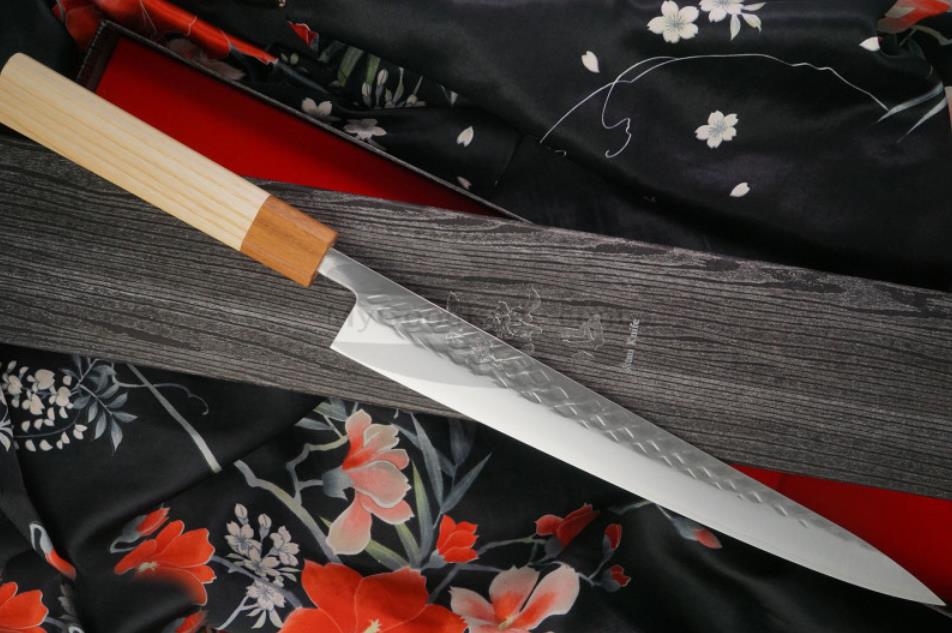
Sujihiki translates to “flesh slicer,” an apt name for an acute-looking knife. There’s a certain charm to this knife that the Yanagiba only rivals.
Its sleek, extended blade ends in a sharp, low point, with some variants featuring a reverse tanto nose. This specialized knife does precisely what the name suggests – carving and slicing roasts, fish, and most other types of raw meat.
The blade’s length allows cutting the meat in a single motion, rather than sawing back and forth, which results in visually appealing slices.
Furthermore, the narrow blade prevents it from sticking to the meat, so chefs can use it for clean slicing or thin, delicate applications like Carpaccio.
Learn more about the Sujihiki:
Sujihiki vs. Yanagiba
The main difference between these knives lies in the type of meat one prepares. A Yanagiba excels with fish and other seafood, while the Sujihiki is more of a carving knife.
Moreover, a Sujihiki can be used successfully with veggies and herbs, while the Yanagi blade is only suitable for raw fish.
The double-beveled edge on the Sujihiki makes it more comfortable for Western users, yet a pro sushi chef will choose the Yanagiba without a doubt.
Learn more about the comparison:
Petty knives
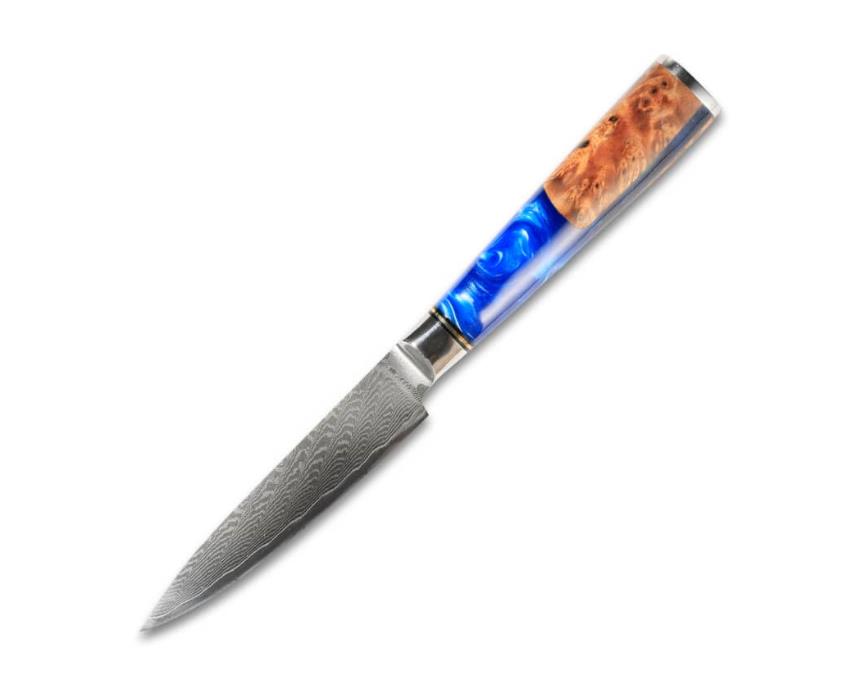
Petty knives are another type of Japanese specialty tool and, contrary to their name, come with zero atittude. They can vary greatly in profile and size, ranging from 75mm to 210mm.
Design-wise, they resemble the Western utility or paring knives, featuring only minor differences that give them their unique Japanese flair.
They can be used for delicate tasks on the cutting board, yet they are mainly used in hand for piercing, peeling, and preparing small ingredients.
Learn more about petty knives:
Honesuki
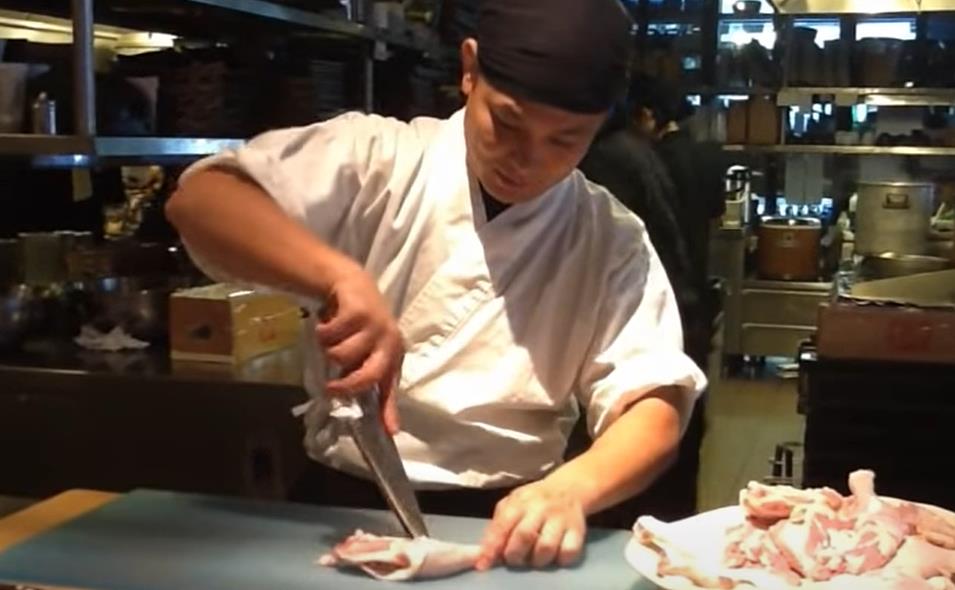
The Honesuki is another small Japanese knife that makes itself most helpful in breaking down and deboning soft meats like chicken. The name translates to “bone knife,” yet the Honesuki might be slightly different from what you’d expect from a Western-style deboning knife.
They have a thicker spine, with an angled cutting edge, tending on the flatter side. The blade ends in a sharp point and generally lacks the flexibility of a boning knife.
However, many users prefer it due to its excellent edge retention, and this lack of flexibility can become quite a blessing when cutting through tougher cartilage or bone.
Although the Honesuki is considered a specialized knife, one can very well use it instead of a petty knife when preparing veggies or fruit.
Learn more about the Honesuki:
Pankiri
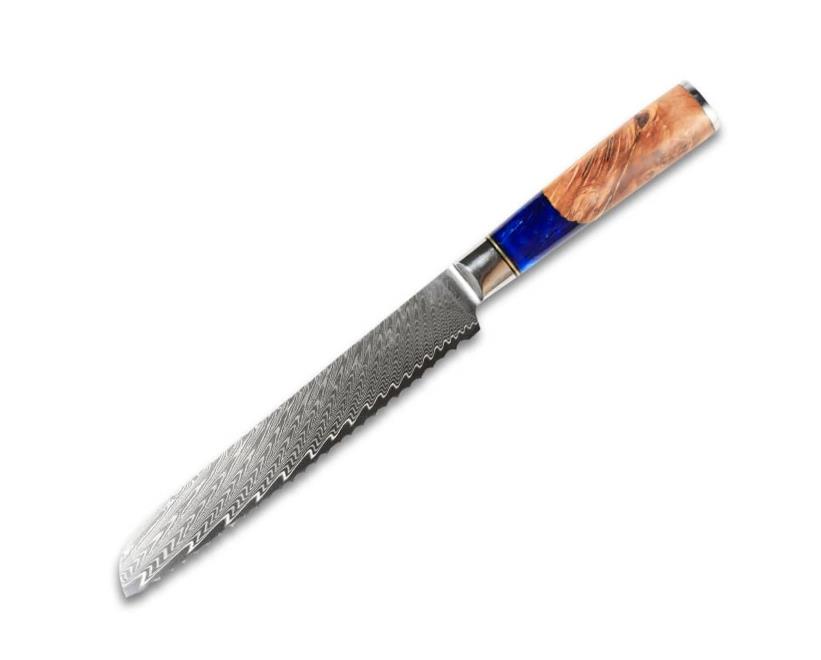
The Pankiri made its debut in Japan post-WWII when bread consumption increased. You guessed it; this makes the Pankiri the Japanese version of a bread knife.
It features a long, narrow, straight blade, typically between 240mm and 360mm.
This knife looks very similar to its Western counterpart, featuring a serrated edge and a skinny blade. Although mainly used for bread, it is also helpful for cutting cake or even braised meats.
Learn more about the Pankiri:
Features of Japanese kitchen knives 201
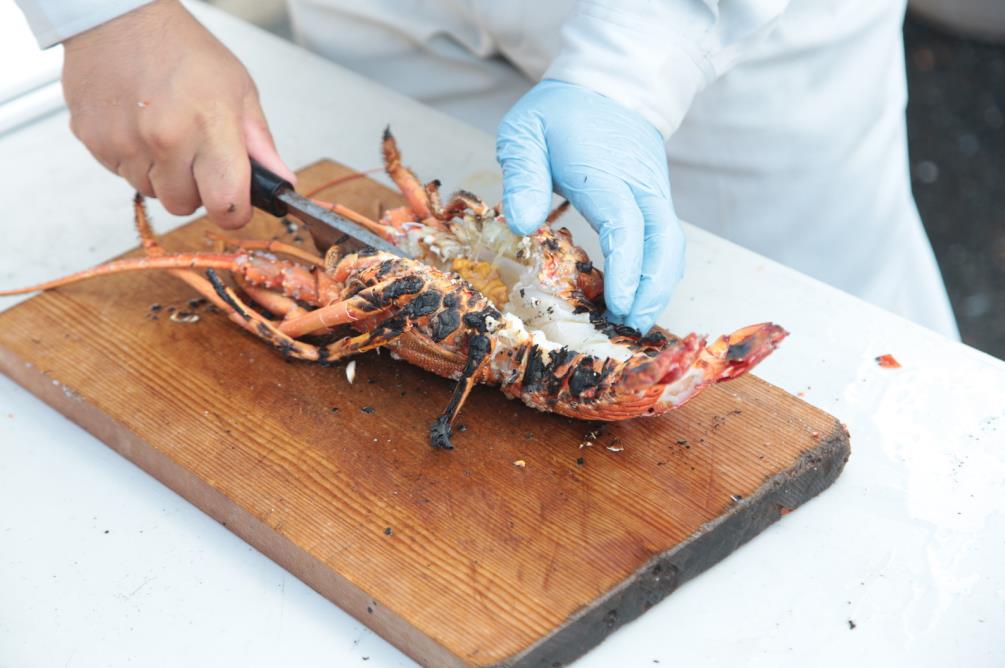
Wa-handle
Traditional Japanese knives usually come with a Wa-handle. These are lighter and offer a better forward balance than the typical Western (Yo) handles.
Since Japanese blades don’t have the thick, riveted tang we’re used to seeing on European blades, they can slide into their handle more easily. Likewise, this makes it easier to replace the handle if it becomes damaged, extending the knife’s lifespan quite a bit.
Generally, these handles have a tang around ¾ of the blade’s length and feature distinctive collars that contrast the exposed wood of the rest of the handle.
Single-bevel
Single or double bevels refer to the surface that has been ground to create a knife’s cutting edge. Looking closely at a blade, you’ll notice a slight angle on one or both sides that runs down to the edge. Those angles are the bevels.
Most traditional Japanese knives come with a single-beveled edge – the angle is formed on only one side. These knives are often referred to as chisel edge.
The main advantage of a single bevel is that it creates an extremely sharp knife, which is essential in Japanese cuisine for preparing delicate ingredients.
High hardness steel
Japanese artisans always took special consideration when choosing their steel, with traditional Katanas being made of tamahagane steel. This material is only produced in the western part of Japan by smelting iron dust and pure coal.
The steel used for the production of knives is made using similar techniques.
Due to the high carbon content, traditional Japanese knives can be forged to a high hardness (60+ HRC) but remain very easy to sharpen and keep their edge for a long time.
Two of the most popular steel used are shiro-ko and ao-ko, which mean white steel and blue steel, respectively.
Should you sell Japanese knives in your store?
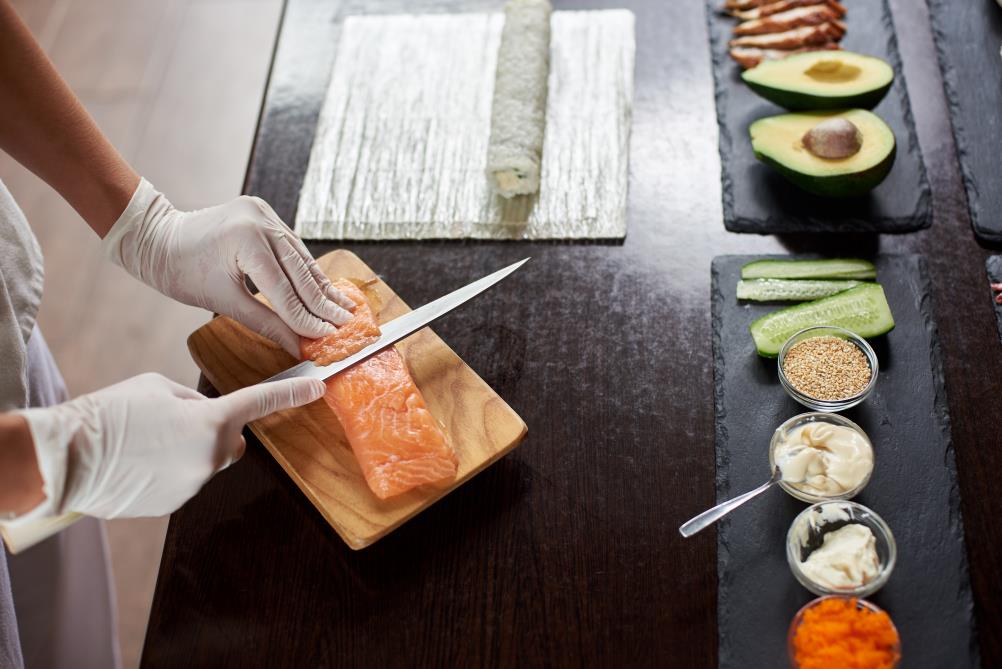
There’s no denying that Japanese knives are very popular choices worldwide. Apart from their elegant designs, these tools are known for their sophistication, durability, and excellent performance.
Few Western chefs in modern times don’t own at least one type of Japanese knife, and home cooks have also taken a liking to them for several reasons.
The Japanese multi-purpose knives are some of the most popular choices, out of which the Gyuto and Santoku knives practically sell themselves.
Buy Wholesale Knives and Start Scaling up with Us Today
Contact us and connect with a sales rep to get a free quote.
Should you make a Japanese knife set?
Many buyers will look for ready-made sets that should include tools fit for the majority of tasks around the kitchen. Of course, creating the perfect set will depend on your general audience, but there are still some rules of thumb you can keep in mind.
To cover a broad range of use cases, a Japanese knife set should include a chef’s knife, such as a Gyuto or Santoku. If you’re going for a specialized set featuring the Kiritsuke as the main item, you can add the cleaver for some of the tougher cutting jobs.
Apart from these, you should include a vegetable knife, such as a Nakiri or Usuba, and a Yanagiba for fish (and aesthetics).
A petty knife or a Honesuki can cover the more delicate jobs and finish the set, but the Pankiri or Sujihiki can also represent valuable additions.
To sum it up:
- Gyuto/Santoku – Chef’s knife
- Nakiri/Usuba – Vegetable knife
- Yanagiba – Fish knife
- Petty knife/Honesuki – Delicate tasks/deboning
- Pankiri/Suijihiki – Specialized knife for bread or meat carving
A glance over your competition will convince you how well Japanese knives sell. The well-known Japanese-style knives are often sold-out, and even the specialty knives quickly find their forever homes.
You can check the raving customer reviews on established Japanese retailers’ sites, such as Miura Knives or Tojiro Japan. And it also wouldn’t hurt to check our Japanese knives catalog.
Finals
We’ve come a long way since first starting this course. With this information under your belt, you are ready to discuss, market, and sell any Japanese kitchen knives.
Whenever you’re ready, contact us for your diploma. We’ll take care of everything else.
